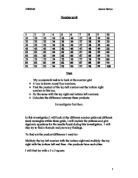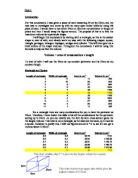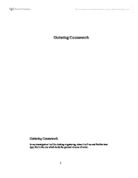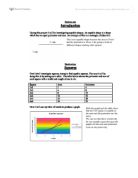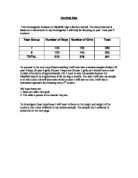Maths Investigative task on perimeter of a rectangle and volume of shapes
MINIMUM PERIMETER . Your task is to find the value of dimension that minimizes the perimeter. By using technology, list all the possible values of length, width, and perimeter with area 1000m2. Data attached at the back. Color code: Yellow shows the best value that matches the requirements, red matches with red and green matches with green. Here is some sample data: Length (m) Width (m) Perimeter (m) Area (m2) 1 1000 2002 1000 2 500 1004 1000 3 333.333 672.667 1000 4 250 508 1000 5 200 410 1000 6 166.667 345.333 1000 7 142.857 299.714 1000 8 125 266 1000 9 111.111 240.222 1000 10 100 220 1000 11 90.909 203.818 1000 12 83.333 190.667 1000 13 76.923 179.846 1000 14 71.429 170.857 1000 15 66.667 163.333 1000 16 62.5 157 1000 17 58.824 151.647 1000 18 55.556 147.111 1000 19 52.632 143.263 1000 20 50 140 1000 21 47.619 137.238 1000 22 45.455 134.909 1000 23 43.478 132.957 1000 24 41.667 131.333 1000 25 40 130 1000 26 38.462 128.923 1000 27 37.037 128.074 1000 28 35.714 127.429 1000 29 34.483 126.966 1000 30 33.333 126.667 1000 31 32.258 126.516 1000 32 31.25 126.5 1000 33 30.303 126.606 1000 34 29.412 126.824 1000 35 28.571 127.143 1000 36 27.778 127.556 1000 37 27.027 128.054 1000 38 26.316 128.632 1000 39 25.641
T-Total Maths coursework
Maths Coursework T Total Introduction In my maths casework I am investigating the relationship between the T-Number and the T-Total, throughout a range of different size grids. I am going to work out the rule for any size grid that is by 10, below is a 9 by 10 grid, the t is the coloured in bit and the red number is the T-Number. So the T-Number is 50 in this 9X10 grid is 50. The T-Total for this T is all the numbers in the T added up 50+41+31+32+33=187 The T-Total would be 187 as this is all the coloured in squares added up. So in my coursework I am going to use different grid sizes to translate the T-Shape to different positions .I will then investigate the relationship between the T-Number and the T-Total, and the grid size. I am then going to use different size grids to try to work out Ts in all different ways. Like the grid below, I am going to work out rules for all the T-Numbers with the T standing different ways. This grid shows the ways in which I am going to work out the T- Number in different ways. Looking for patterns and predicting the next T 9X10 Grids I am first going to work out the T-Total for 5 consecutive Ts, starting at 20 and going up to 24. T-Number = 20 T-Total = 37 T-Number = 21 T-Total = 42 T-Number = 22 T-Total = 47 T-Number = 23 T-Total = 52 T-Number = 24 T-Total = 57 T-Number T-Total 20 37 21 42 22 47 23 52 24 57
Number grids
NUMBER GRIDS 2 3 4 5 6 7 8 9 0 1 2 3 4 5 6 7 8 9 20 21 22 23 24 25 26 27 28 29 30 31 32 33 34 35 36 37 38 39 40 41 42 43 44 45 46 47 48 49 50 51 52 53 54 55 56 57 58 59 60 61 62 63 64 65 66 67 68 69 70 71 72 73 74 75 76 77 78 79 80 81 82 83 84 85 86 87 88 89 90 91 92 93 94 95 96 97 98 99 00 The aim of my investigation is to find the cross product difference of various grid sizes and see what I notice about this. I will try to find out a pattern from when I change the grid sizes. I will get a 10 by 10 table ranging from 1-100 and start off using squares, i.e. 2x2, 3x3, 4x4 e.c.t. I will take the two opposite corners and multiply them together doing the same on both sides, I will take the two final numbers and subtract them from one another, this will leave me with a number, which should be the same for each of the same sized grid shapes. I will place my results into a table and see if I can work out a formula for finding out all the results. 2x2 2 3 22 23 (13x22) - (12x23) = 286-276 = 10 5 6 25 26 (16x25)-(15x26) = 400-390 = 10 77 78 87 88 (78x87)-(77x88) = 6786-6776 = 10 81 82 91 92 (82x91)-(81x92) = 7462-7452 = 10 33 34 43 44 (34x43)-(33x44) = 1462-1452 = 10 In all of the small 2x2 number grids above I have found out that the product of the
Layers investigation
Layers I am carrying out an investigation to find out the different arrangements of cubes on a specified grid size. I will first start off with a two by three grid size which means there are six squares in the grid. On these six squares I will put five cubes. Each cube must fit exactly onto one square. During the course of my investigation I will display and describe my work and findings. I first investigated how many different arrangements of the five cubes there were on a 2 by 3 grid. The 2 by 3 grid obviously has 6 squares; as one square always has to stay blank, the other five squares will be filled in. Because there are six squares and one square is always blank, there are six different variations. For the second layer, there are only five squares, one of which has to stay blank. Because of this four squares can be filled, and this produces 5 different arrangements. As you can see the total number of different combinations is 30. This can also be worked out by saying that there are five different arrangements on the second layer and there are six different arrangements on the first layer. So if you calculate 5*6 you get the answer 30. There is a theory behind this to find out the number of different arrangements without drawing the layers: "The number of squares filled in is always -1 of the number of arrangements and the number of possible empty squares." To
number grid
2 3 4 5 6 7 8 9 0 1 2 3 4 5 6 7 8 9 20 21 22 23 24 25 26 27 28 29 30 31 32 33 34 35 36 37 38 39 40 41 42 43 44 45 46 47 48 49 50 51 52 53 54 55 56 57 58 59 60 61 62 63 64 65 66 67 68 69 70 71 72 73 74 75 76 77 78 79 80 81 82 83 84 85 86 87 88 89 90 91 92 93 94 95 96 97 98 99 00 Number grid Task My coursework task is to look at the number grid * A box is drawn round four numbers. * Find the product of the top left number and the bottom right number in this box. * Do the same with the top right and bottom left numbers. * Calculate the difference between these products. Investigate further. In this investigation I will look at the different number grids and different sized rectangles within these grids, I will explain the patterns and give algebraic equations for the results found during this investigation. I will also try to find a formula and prove my findings. To find out the product difference I need to:- Multiply the top left number with the bottom right and multiply the top right with the bottom left and then - the products from each other. I will first try with a 2 x 2 square. 2 13 22 23 a) 2 x 23 = 276 The difference of the two products are 10. 3 x 22 = 286 I worked the difference out by doing, 286-276 = 10 38 39 48 49 b) 38 x 49 =
Tubes. I was given a piece of card measuring 24 cm by 32cm, and my task was to investigate and come up with as many open ended tubes by using this piece of card
Introduction: For this coursework, I was given a piece of card measuring 24 cm by 32cm, and my task was to investigate and come up with as many open ended tubes by using this piece of card. I would have to use either 24cm or 32cm as my perimeter or length of prism and then I would swap the figures around. The purpose of this is to find the maximum volume for a particular shape. I will begin this coursework by starting with a rectangle, as this is the easiest shape to start of with, and slowly work my way with the following shapes: square, triangle, pentagon, hexagon, heptagon, octagon and cylinder. This will then give me a brief outline of the shape volumes. Throughout the coursework I will be using this formula to help me find the volume: Volume = area of cross-section x length To start of with I will use the 24cm as my constant perimeter and the 32cm as my constant length. Rectangle and Square Length of rectangle Width of rectangle Area in cm2 Volume in cm3 1 1 352 2 0 20 640 3 9 27 864 4 8 32 024 5 7 35 120 6 6 36 152 7 5 35 120 8 4 32 024 9 3 27 864 0 2 20 640 1 1 352 For a rectangle there are many combinations for you to have the perimeter as 24cm. Therefore, I have drawn this table to list all the combinations for the perimeter adding up to 24cm. As you can clearly see, the 6cm by 6cm cross-section gives me the
Guttering Investigation
Guttering Coursework Guttering Coursework In my investigation I will be looking at guttering, where I will try and find the best type; that is the one which holds the greatest volume of water. I was walking around my hometown of Antrim where I noticed how all the guttering was made into a semi circular open top shape. I wondered if this is because this is the shape which holds most water or is it because it is the cheapest to manufacture. My hypothesis is that semi circular guttering will hold the greatest volume of water. I will now investigate to see whether my hypothesis is true of whether there is another which can hold a larger volume of water. I will use a sheet of plastic and fold it into different shapes. I will find out the shapes' cross sectional area rather than the volume as it is easier and the length will be the same so it is only the cross sectional area that varies. I will fold a sheet of paper into different shapes to help me visualise the different shapes possible. I will be investigating guttering which will have a perimeter of "B" cm. In one case I will be using "18cm" which happens to be the length of the piece of paper I am using. Semi Circular Guttering Cross Section As this appears to be the most commonly used guttering and it is the type I have based my hypothesis on, I shall investigate its cross sectional area first so I can use it as a
The Weight of Your School Bag
Statistics Coursework The Weight of Your School Bag Introduction: My Chosen Topic is The Average Weight of the School Bag of Students in Year Ten at the Start of the week and just before it ends, as it seems to be a topic that no one actually thinks about all that much, but students sometimes complain how heavy there bags seem to be. Hypothesis: The Hypotheses I present on my topic are: * The Weight of the Bag will be Slightly Heavier as it is the start of the week, and students have a lot of work to turn in * The Weight of the Bag will be Slightly Lighter as it is just before the end of the week. * The Weight will also depend on the Miscellaneous Items the Student is carrying, so it is hard to determine which gender will have the Heavier bag but it should be about the same Questionnaire: There was a little bit of difficulty in making the questionnaire for me, as I wanted specific results whilst keeping the questionnaire as simple as possible. First I had decided upon using Monday and Friday to compare but a lot of students have similar classes on both days so there wouldn't much to compare whereas Thursday was just before the end of the week, and I decided to use it instead. There was also another problem that students did not have a scale to measure the weight of the Bag in Kilograms (Kg) and/or Pounds (Lbs) and /or Stone (St,), so I had to decide what scale to use,
Equable shapes
Section one Introduction During this project I will be investigating equable shapes. An equable shape is a shape which has an equal perimeter and area. An example of this is a rectangle of sides 6x3. Section two Squares First I shall investigate squares, trying to find equable squares. The way I will be doing this is by setting out a table. The table below shows the perimeter and area of each square with a width and length of one to six. Square Area Perimeter x1 4 2x2 4 8 3x3 9 2 4x4 6 6 5x5 25 20 6x6 36 24 Now I will use my table of results to produce a graph. Section Three Rectangles I started investigating rectangles by filling in different tables. The first table I did kept a fixed width of 1 (shown below is the table showing my results). Rectangle Area Perimeter x1 4 x2 2 6 x3 3 8 x4 4 0 x5 5 2 x6 6 4 x7 7 6 x8 8 8 x9 9 20 Rectangle Area Perimeter 2x1 2 6 2x2 4 8 2x3 6 0 2x4 8 2 2x5 0 4 By looking at this graph we can see that the linear graphs for area and perimeter are parallel. This suggests that we can't have an equable rectangle with a width of 2. Now I will try to prove this algebraically. Area = 2L Perimeter = 2L+4 2L=2L+4 2L-2L=4 0L=4 L= Clearly, you can't have a rectangle that is infinitely long. I was right in thinking an equable rectangle with a fixed width of 2 doesn't
Box Coursework
Mayfield High This investigation is based on Mayfield high a factious school. The data presented is based on a real school. In my investigation I will only be focusing on year 7 and year 9 students. Year Group Number of Boys Number of Girls Total 7 53 33 286 9 20 45 265 TOTAL 273 278 551 To proceed to the next step of data handling I will now take a random sample of about 30 year 9 boys, 30 year 9 girls, 30 year 7 boys and 30 year 7 girls, so I should have a total number of students of approximately 120. I need to take this sample because the Mayfield data in its original state is far too big to handle. The way I will take my sample is to role a dice this will determine which student I will start on then I will take a systematic approach by choosing every 5th student. My hypotheses are: . Boys are taller than girls 2. The taller a person is the heavier they are. To investigate these hypotheses I will need to focus on the height and weight of the students that I have collected in my random sample. The sample that I collected is presented on the next page. Now that I have my samples of data I will present then in the form of a cumulative frequency table. Boys Height (cm) Tally Frequency Cumulative Frequency 30?h<140 l 40?h<150 lllll l 6 7 50?h<160 lllll lllll lllll lllll lll 23 30 60?h<170 lllll lllll llll 4 44 70?h<180 lllll






